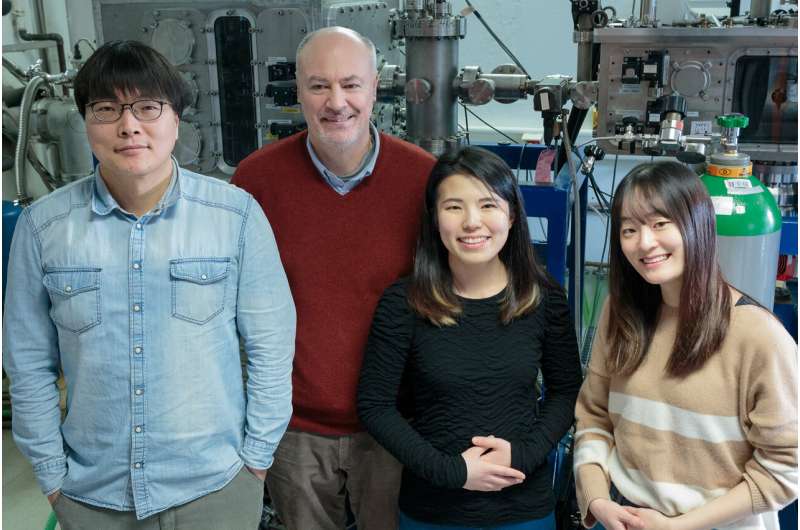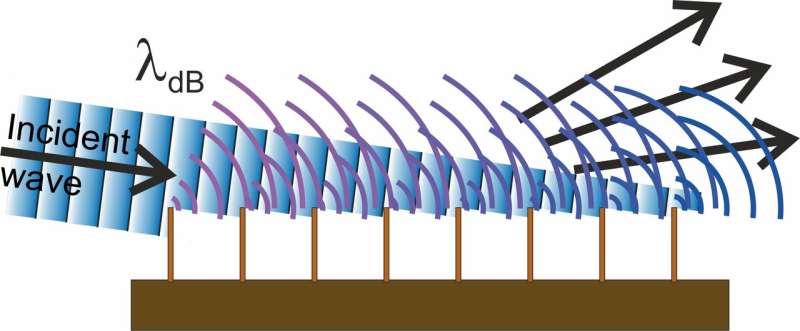February 20, 2019 feature
Observing matter-wave diffraction from a periodic array of half planes

Researchers at Ulsan National Institute of Science and Technology (UNIST), in Korea, and Fritz-Haber-Institut der Max-Planck-Gesellschaft, in Germany, have recently conducted a study investigating matter-wave diffraction from a periodic array of half planes. Their paper, published on Physical Review Letters (PRL), reports on the reflection and diffraction of He and D2 beams from square-wave gratings of a 400−μm period and strip widths ranging from 10 to 200 μm at grazing-incidence conditions.
"Our experiment is based on the wave–particle duality, which is a basic concept in quantum mechanics," Wieland Schöllkopf, one of the researchers who carried out the study, told Phys.org. "The idea that microscopic particles such as electrons, neutrons, atoms or even molecules exhibit wave-like behavior dates back to the 1920s, when Louis de Broglie introduced the particle wavelength, which today is referred to as the 'de Broglie wavelength.'"
Since de Broglie first developed his theory, researchers have carried out numerous experiments observing diffraction and interference, two wave phenomena that cannot be explained in a particle picture. The main aim of the study carried out by Schöllkopf and his colleagues was to investigate novel matter-wave diffraction methods that allow for coherent manipulation of atomic and molecular beams.
"We observed diffraction of He atoms and D2 molecules scattering off from a grating structure," Schöllkopf explained. "The latter is formed by a periodic array of polymer film structured on a gold-coated glass substrate. A variety of grating structures, all with identical period, but differing in the width of the polymer stripes, were made at UNIST in Ulsan, Korea. These gratings were used in the diffraction apparatus at the Fritz-Haber-Institut in Berlin, Germany."
The apparatus at the Fritz-Haber-Institut allowed the researchers to generate an intense beam of He or D2 with extremely narrow angular divergence. The generated beam is incident to the grating under grazing conditions, hence, the particles' velocity component perpendicular to the grating surface is very small.
"In previous experiments carried out at our lab, we have observed coherent reflection and diffraction from a grating structure under grazing incidence conditions," Schöllkopf said. "This was attributed to 'quantum reflection,' which is a reflection mechanism different from classical reflection."
In classical reflection, as atoms or molecules approach a surface, they are affected by the atom-surface van der Waals force. This force leads to an acceleration towards the surface, with the particle ultimately bouncing off from the surface. On the other hand, in quantum reflection, the atoms or molecules already bounce back from the region in space dominated by the van der Waals force.

"This counter-intuitive quantum effect of attractive forces, effectively resulting in recoil of the particle, can only be observed if the incident velocity in the direction perpendicular to the surface is very small," Schöllkopf explained. "This is why, in our experiment, we can only observe quantum reflection at near grazing incidence conditions."
A third reflection mechanism, which differs from classical and quantum reflection, is based on the diffraction of the de Broglie waves of atoms or molecules from the edges of half planes, which are very narrow ridges on a surface. This mechanism, first observed in Japan by Prof. Shimizu and his colleagues, is now referred to as "Fresnel diffraction mirror" due to its analogy with the edge diffraction of light waves in optics.
In their study, Schöllkopf and his colleagues observed fully resolved matter-wave diffraction patterns, including specular reflection and diffracted beams up to the second diffraction order. They also found that as strip width decreased, diffraction efficiencies transformed from the known regime of quantum reflection to the regime of edge diffraction.
"In our experiment, we observed the transition from quantum reflection for relatively large widths of the grating stripes to the regime at small stripe widths where edge diffraction dominates," Schöllkopf said. "Furthermore, in addition to the specular (mirror-like) reflection seen previously, we observed intense grating diffraction beams up to second order."
The experimental findings collected by the researchers confirm a previously developed single-parameter model, which is commonly used to describe a variety of phenomena, including quantum billiards, scattering of radio waves in urban areas and the reflection of matter waves from microstructures. Moreover, their observations suggest that neither classical nor quantum reflection mechanisms are essential for the reflective diffraction of matter waves from a structured solid, as this can result exclusively from half-plane edge diffraction.
"Our observations allowed us to make a quantitative analysis of the reflection and diffraction efficiencies," Bum Suk Zhao from UNIST, the principle investigator of the study, told Phys.org. "This, in turn, allowed for an experimental test of the Bogomolny-Schmit model of half-plane array diffraction. According to this model description the phenomenon is fully scalable with respect to the wavelength and the dimensions of the half-plane array. As a result, for a given incidence angle, the scattering of atomic matter waves of 1 nm de Broglie wavelength from a 4-μm-period array of parallel half planes shows identical diffraction effects as, e.g., the scattering of 1-cm-wavelength radio waves off buildings separated by 40 m."
The study conducted by Schöllkopf, Zhao and their colleagues provides a clear confirmation of the Bogomolny-Schmit model. In the future, their findings could also be used as a test bench for models of quantum reflection from microstructured surfaces that need to account for half-plane edge diffraction. In their next studies, the researchers plan to apply half-plane array diffraction to the investigation of weakly bound molecules, such as the He dimer and trimer.
"Due to their extremely small binding energies, these di- and triatomic helium molecules are not amenable to many experimental tools," Bum Suk Zhao explained. "For instance, classical scattering of He2 from a solid surface will inevitably lead to break-up. To overcome these limitations, more experimental techniques allowing for non-destructive manipulation of these species are needed. Half-plane array diffraction is a well suited method for this purpose."
More information: Ju Hyeon Lee et al. Matter-Wave Diffraction from a Periodic Array of Half Planes, Physical Review Letters (2019). DOI: 10.1103/PhysRevLett.122.040401
Hilmar Oberst et al. Fresnel Diffraction Mirror for an Atomic Wave, Physical Review Letters (2005). DOI: 10.1103/PhysRevLett.94.013203
Journal information: Physical Review Letters
© 2019 Science X Network


















